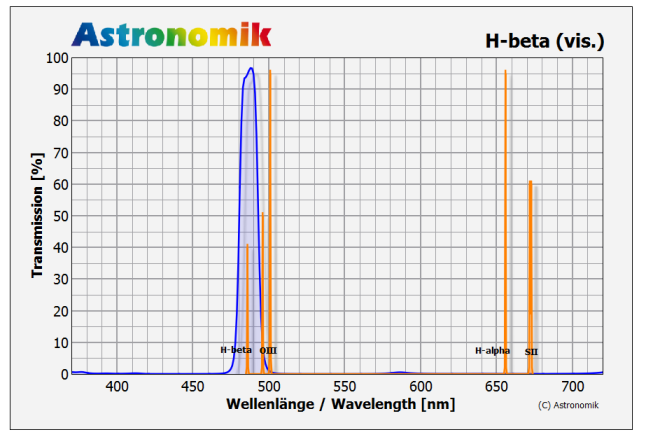- Astronomik Lunar calendar for 2024
The Astronomik calendar of the Lunar phases in 2024 is ready.
- Chistmastime and New Year 2023-2024
We wish you a merry Chirstmastime and a happy and healthy 2024...
- Astronomik Lunar calendar for 2023
The Astronomik calendar of the Lunar phases in 2023 is ready.
- Chistmastime and New Year 2022-2023
We wish you a merry Chirstmastime and a happy and healthy 2023...
- Shipping methods
Shipping as registred good shipment is no longer available
- How to observe planetary nebulae
A very nice introduction to observing planetary nebulas written by Owen Brazell
- Astronomik Lunar calendar for 2022
The Astronomik calendar of the Lunar phases in 2022 is ready.
- Website down
Our website was down on dec 20st...
- H-alpha imaging with a unmodified EOS R
Imaging with an unmodified camera using a H-alpha filter
- Astronomik Lunar calendar for 2021
The Astronomik calendar of the Lunar phases in 2021 is ready.
Astronomik H-beta Filter
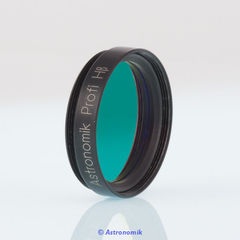
Click the image for full resolution
The Astronomik H-beta is a filter for visual observation, in particular with instruments of larger aperture.It lets the light of the H-beta emission line pass nearly unhindered and blocks the remaining spectral range to the extent that the eye is dark adapted. By the use of the Astronomik H-beta filter, the contrast is increased so strongly, that even the observation of the Horse Head Nebulae with telescopes of 10" - 12" reaches the realm of the possible.
Main use
The optimal aperture ratio for the use of the filter is 1:4,5 to 1:6. The range of application extends from 1:3.5 to 1:15. Transmission losses and chromatic distortions, which arise with other filters, are only apparent with the Astronomik filters when extremely fast aperture ratios of 1:3 and higher are used. The Astronomik H-beta filter will allow you to view large objects, in the whole field of view of the eyepiece, even when using wide-angle eyepieces - not only in the center of the eyepiece. This filter should be used on telescopes with a diameter of 8 " (20cm) or larger. Smaller instruments do not gather enough light for meaningful and satisfying astronomical work. Due to the high optical quality of the Astronomik H-beta filter substrate you will see the same needle-sharp stars as you would from your regular telescope.
Other uses
- In the whole sky, there are few objects that benefit from the use of this filter in visual observation. On the other hand h-beta filters often decide about seeing or not seeing an object. Without a filter the eye is hardly able to discover the low contrasts of H-alpha regions.
- With EOS Clip Filter even in extreme light polluted areas photography with DSLR cameras becomes possible.
more information about the visual Astronomik filters
How to read the chart
The major emission lines of artifical light pollution:
| Hg 435,8nm | Hg 546,1nm | Hg 577,0nm | Hg 578,1nm |
| Na 589,0nm | Na 589,6nm | Na 615,4nm | Na 616,1nm |
The major emission lines of nebulas:
H-β 486,1nm | OIII 495,9nm | OIII 500,7nm | H-α 656,3nm
- The horizontal axis is the Wavelength in Nanometers (nm). 400nm is deep blue, at 520nm the human eye senses green and at 600nm red. At 656nm is the famous "H-Alpha" emission line of hydrogen.
- The transmission in % is plotted on the vertical axis.
- The red line shows the transmission of the filter.
- Visual filters: The grey line in the background shows the relative sensitivity of the human eye at night. The maximum is at ~510nm and drops to longer and shorter wavelengths. You can easily see, that you can´t see anything of the H-alpha line at night (even if you can during daylight!) The sensitivity at 656nm is 0% at night!
- Photographic filters: The grey line in the background shows the sensitivity of a typical CCD sensor.
- The most important artifical emission lines are shown in orange. The artifical light pollution is dominated by see mercury (Hg) and sodium (Na), which are used in nearly all streetlights.
- The most important emission lines from nebulas are shown in green. The most important lines are from ionized Hydrogen (H-alpha and H-beta) and double ionized oyxgen (OIII).
The major emission lines of artifical light pollution:
| Hg 435,8nm | Hg 546,1nm | Hg 577,0nm | Hg 578,1nm |
| Na 589,0nm | Na 589,6nm | Na 615,4nm | Na 616,1nm |
The major emission lines of nebulas:
H-β 486,1nm | OIII 495,9nm | OIII 500,7nm | H-α 656,3nm
Suitability
- Visual observation (dark skies): Very good, but only suitable for a few objects
- Visual observation (urban skies): Unsuitable
- Film photography: It depends, very long exposure time
- CCD photography: Good, when used with an additional IR-block-filter
- DSLR photography (original): Very good, but only suitable for a few objects
- DSLR photography (astro modified): Very good, but only suitable for a few objects
- DSLR photography (MC modified): Good, when used with an additional IR-block-filter
- Webcam / Video (Planets): Unsuitable
- Webcam / Video (Deep Sky): Unsuitable
Technical Data
- typ. transmission of better then 95% at the H-beta line
- complete blocking of all disturbing wavelengths
- Main operational use: Hydrogen Nebulae
- No moisture (humidity) sensitivity, no aging, and totally scratch-proof
- Excellent carrier material - substrate is optically polished. The optical performance (resolution & contrast) of your telescope is not reduced in any way by the filter.
- Parfocal with other Astronomik filters
- Glass thickness: 1mm
- Completely resistant against high humidity, scratches and aging effects
- Diffraction limited, the filter will not reduce the optical performance of your telescope!
- Astronomik filters are delivered in a high-quality, long lasting, filter box
The filter is available in the following sizes
H-beta Filter
-
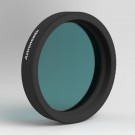
Astronomik H-beta visual T-Mount (M42x0,75)
excl. VAT (Non-EU): €167.23 incl. VAT (EU): €199.00 -
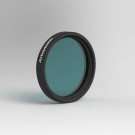
Astronomik H-beta visual 1,25'' (M28,5)
excl. VAT (Non-EU): €83.19 incl. VAT (EU): €99.00 -
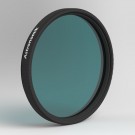
Astronomik H-beta visual 2'' (M48)
excl. VAT (Non-EU): €167.23 incl. VAT (EU): €199.00
-
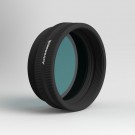
Astronomik H-beta visual SC Rear Cell (2'' / 24TPI)
excl. VAT (Non-EU): €192.44 incl. VAT (EU): €229.00

 Deutsch
Deutsch English
English